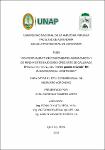Comportamiento de componentes agronómicos y de rendimiento bajo dosis creciente de gallinaza en Cucumis melo L., var. "melón gaucho redondo" en Zungarococha-Loreto.2021
Abstract
The experiment was developed in the Workshop of Teaching and Research of Horticultural Plants (TEIPH), of the Faculty of Agronomy-UNAP, located at Km. 3.5 of the road to Quistococha -Llanchama, south of the city of Iquitos, whose geographical coordinates are: South Latitude 03º 46 ? 13.2 ? ?; West Longitude 73º 22 ? 10.4´´; Altitude: 126 masl. The type of research was quantitative, experimental, explanatory, transversal and prospective, with an independent variable (Chicken dose) and eight dependent variables (Number of fruits/plant, Number of fruits/plot, length of the fruit, diameter, thickness of the bark of the fruit, weight of fruit, weight of fruits/plant and weight of fruits/ha). The objective of the research was to determine the behavior of the agronomic and yield components under increasing dose of chicken in Cucumis melo L., var. "round gaucho melon", in Zungarococha-Loreto. 2021.The Statistical Design employed was the Completely Random Block Design, with four treatments and four repetitions. Each experimental unit consisted of 2 rows, 5 plants/row, 3 seeds/stroke and the sampling unit consisted of 4 plants/experimental unit. experiment, the following conclusions were reached: The T4 Treatment (60 t henza/ha) presented the best agronomic characteristics and yield, with 5 fruits/plant, 16 cm of fruit length, 13 cm of fruit diameter, 2 mm of bark thickness, 1,248 g of fruit weight and 9,360 Kg of fruits/ha; in addition, it presented better profitability, with S/.18,738.00. El experimento se desarrolló en el Taller de Enseñanza e Investigación de plantas Hortícolas (TEIPH), de la Facultad de Agronomía-UNAP, ubicada en el Km. 3.5 de la carretera a Quistococha – Llanchama, al Sur de la ciudad de Iquitos, cuyas coordenadas geográficas son: Latitud Sur 03º 46´ 13.2´´; Longitud Oeste 73º 22´ 10.4´; Altitud: 126 msnm. El tipo de investigación fue cuantitativo, experimental, explicativo, transversal y prospectivo, con una variable independiente (Dosis de gallinaza) y ocho variables dependientes (Numero de frutos/planta, Numero de frutos/parcela, largo del fruto, diámetro, grosor de la corteza del fruto, peso de fruto, peso de frutos/planta y peso de frutos/ha). El objetivo de la investigación fue Determinar el comportamiento de los componentes agronómicos y de rendimiento bajo dosis creciente de gallinaza en Cucumis melo L., var. “melón gaucho redondo”, en Zungarococha-Loreto. 2021.. El Diseño Estadístico empleado fue el Diseño de Bloques Completamente al Azar, con cuatro tratamientos y cuatro repeticiones. Cada unidad experimental estuvo constituida de 2 filas, 5 plantas/fila, 3 semillas/golpe y la unidad de muestreo estuvo constituida por 4 plantas/unidad experimental. Al término del experimento se llegó a las siguientes conclusiones: El Tratamiento T4 (60 t gallinaza/ha) presentó las mejores características agronómicas y rendimiento, con 5 frutos/planta, 16 cm de largo de fruto, 13 cm de diámetro de fruto, 2 mm de grosor de corteza, 1,248 g de peso de fruto y 9,360 Kg de frutos/ha; además, presentó mejor rentabilidad, con S/.18,738.00.
Collections
- Tesis [670]


